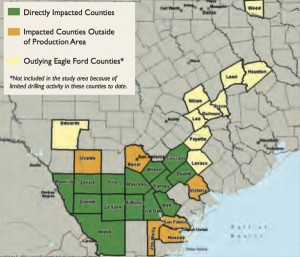EOG Resources' monster Eagle Ford wells are getting bigger! The company brought one of its best producing wells to date in the third quarter of 2012. The Baker-DeForest Unit #4H tested at 4,598 b/d of oil and 4 mmcfd of rich natural gas at normal choke rates. At LLS oil prices, the well is yielding gross revenue of almost $500,000 per day! It doesn't matter what the decline curve looks like. A well like this will potentially pay back in the first month of production. It's a boon for mineral owners too. The well will pay between $50,000-$100,000 per day to royalty owners. You can read more about the company's biggest well here: EOG Reports Record Eagle Ford Well.
In Gonzales County, the Baker-DeForest Unit #4H came on line at 4,598 barrels of oil per day (Bopd) with 488 barrels per day (Bpd) of natural gas liquids (NGLs) and 2.9 million cubic feet per day (MMcfd) of natural gas. The Baker-DeForest Unit #1H, #2H, #3H and #12H were turned to sales at initial rates ranging from 3,346 to 4,216 Bopd with 457 to 537 Bpd of NGLs and 2.7 to 3.2 MMcfd of natural gas. EOG has 100 percent working interest in these five Baker-DeForest wells.
EOG's monster wells are are defined by the company as having initial production rates of 2,500-4,800 barrels of oil production per day plus natural gas and NGLs. The company completed 16 monster wells in the second quarter of 2012 and brought on 12 more in the third quarter.
EOG's Eagle Drilling Cost is Falling
EOG's average well costs in the play are falling near $5.5 million as the company realizes the benefits of sourcing its own frac sand, improving service costs, and increased operational efficiencies.
The company's average drill time has fallen to 13 days per well. That means a lot of wells can be drilled with 20 rigs active. EOG will drill 320 net wells in 2012 alone.
[ic-c]
EOG Operations Expand Across South Texas
EOG's production eclipsed 109,000 boe/d in the quarter - 75% oil, 13% NGLs, and 12% natural gas. The play has been the biggest driver of crude oil production growth across the company's portfolio. The four main takeaways from the company's Eagle Ford update were:
- Monster Wells are improving – 16 wells came online with IPs between 2,500 and 4,800 b/d of oil
- Th company continues to test multi-well pilots at denser spacing (65-90 acres)
- Oil is being priced at LLS, which is trading at a premium to WTI
- Average well costs are falling near $5.5 million
- 20 rigs are expected to drill 320 net wells in 2012, with an average drilling time that has decreased to 13 days per well.
EOG also completed notable wells in McMullen County and La Salle County:
- In McMullen County, the Lowe Pasture #9H and #10H produced at initial production rates of 1,905 and 2,075 b/d oil, 112 and 115 b/d NGLs, and 673 and 688 mcfd of natural gas
- In La Salle County, the Martindale L&C #1H and #2H came online at 1,522 and 1,876 b/d oil, 220 and 208 b/d NGLs and 1.3 and 1.2 mmcfd of natural gas
Near the DeWitt County line in Gonzales County EOG reported the following:
Reilly Unit #1H had an initial oil production rate of 3,579 Bopd with 483 Bpd of NGLs and 2.9 MMcfd of natural gas. EOG has 70 percent working interest in this well. Also in the new area northeast of the Reilly, the Boysen Unit #1H and Baird Heirs Unit #4H were completed at 2,540 and 2,242 Bopd with 268 and 181 Bpd of NGLs and 1.6 and 1.1 MMcfd of natural gas, respectively. EOG has 100 percent working interest in both wells. EOG also has 100 percent working interest in the Henkhaus Unit #8H, which was completed offsetting the previously drilled Henkhaus Unit #10H and #11H. The #8H had an initial production rate of 4,012 Bopd with 495 Bpd of NGLs and 3.0 MMcfd of natural gas.





